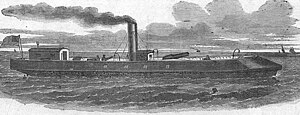USS Naugatuck (1844)

USRC E. A. Stevens operating in the Hampton Roads area, Virginia.
|
|
| History | |
|---|---|
|
|
|
| Name: | USRC Naugatuck |
| Namesake: | An Indian word meaning “one tree” or “fork of the river.” |
| Operator: | US Revenue Cutter Service |
| Laid down: | 1844 |
| Launched: | at New York City in 1844 |
| In service: | March 1862 |
| Out of service: | 1889 |
| Renamed: | USRC E. A. Stevens, 1862 |
| Struck: | 1890 (est.) |
| Nickname(s): | "Hoboken Ironclad" |
| Fate: | continued in use as the USRC Naugatuck until sold in 1890 |
| Status: | afterwards known as the merchant vessel Argus |
| General characteristics | |
| Class and type: | Armored gunboat |
| Type: | twin-screw semi-submersible |
| Tonnage: | 192 register tons (544 m³) |
| Length: | 110 ft (33.5 m) |
| Beam: | 20 ft (6.1 m) |
| Draft: |
|
| Propulsion: |
|
| Speed: |
|
| Complement: | 24 officers and men |
| Armament: |
|
| Armor: | iron-plate belt at gunwale |
USRC Naugatuck was a twin-screw ironclad experimental steamer owned by the US Revenue Cutter Service during the American Civil War. She served the U.S. Treasury Department as the USRC E.A. Stevens (later Naugatuck), a name she retained until sold in 1890. She was loaned to the Navy by the Treasury Department and thus mistakenly referred to in US Navy dispatches during early 1862 as "USS Naugatuck".
In 1841, Robert L. Stevens and Edwin Augustus Stevens — the sons of Colonel John Stevens of Hoboken, New Jersey — proposed to the Navy Department the construction of an ironclad vessel of high speed, with screw propellers and all machinery below the waterline. This proposal was accepted and an Act of Congress — approved on 14 April 1842 — authorized the Secretary of the Navy to contract for the construction of a shot and shell-proof steamer, to be built principally of iron, on the Stevens plan. The armor was to be 4.5 in (11 cm) thick, a thickness believed by the Stevenses to be sufficient to resist any gun then known. But experiments made by John Ericsson with his big wrought-iron gun proved that 4.5 inches of armor was insufficient, and the construction of the vessel was thus delayed. In 1854, the builders constructed a larger battery, to be plated with 6.75 in (17.1 cm) of iron, but this in turn was never finished. This vessel was referred to as the Stevens Battery.
To demonstrate the practicality of the plan of the "Stevens Battery", the Stevens brothers bought, modified and fitted out at their own expense a small prototype. The iron steamer — originally named Naugatuck — was built in 1844 by H.R. Dunham & Company, a New York City locomotive builder, for the Ansonia Copper and Brass Company. During the 1850s, Naugatuck ran between New London and New York.
...
Wikipedia
